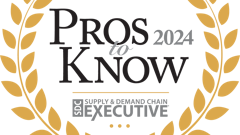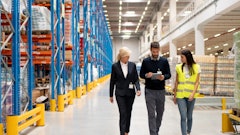It is nearly impossible to return from a shopping trip without seeing Earth-friendly products or to watch or read the news without encountering a story about the environment. Businesses today need to focus on the complex issues of sustainability. Declining to do so may cost them dearly in today’s competitive marketplace of environmentally aware consumers.
Procurement processes that support the design and management of a sustainable supply chain are becoming critical for providers of goods and services in nearly every part of our economy. In releasing its annual list of “Top 10 Supply Chain Predictions for 2008,” Manufacturing Insights, part of the global technology market research firm IDC, gave the No. 1 spot to “Your suppliers’ problems become your own, especially when they are related to sustainability.” Sustainability, the firm predicted, will be the new metric for the supply chain. “It will no longer be enough to look for sustainability in your own operations, but in your suppliers’ operations as well. Sustainability will become more than just ‘green IT’ and environmental packaging. It will extend to things like social corporate responsibility, postponement and better use of logistics/transportation,” the report said.
The Talent Question
This is a tall order. Do companies have the necessary management expertise to tackle this increasingly complex issue? It is a question that is keeping more than a few C-suite executives awake at night.
Sixty-nine percent of the 90 companies interviewed by Capgemini Consulting for its 2008 Chief Procurement Officer survey rated competency development as a clear area of activity. Nearly one-third of survey respondents said developing the necessary talent was a top five critical issue.
Korn/Ferry’s own research confirms that management of procurement talent is top of mind. In a survey on environmental and sustainability issues conducted by Korn/Ferry with 1,500 executives across functions, industries and geographies, nearly half said that their companies were hiring new staff to support environmental initiatives, reassigning existing staff for that purpose or employing a combination of both tactics. In addition, nearly 30 percent of respondents believe that sustainability efforts will not take a back seat to profitability in the economic downturn, indicating that the need for experienced procurement executives will likely increase, not decrease.
Sustainability in a business context is very much a moving target. The amount of information available varies greatly. Standards for “benchmark” practices often differ, and the math behind what really creates a sustainable and economically viable solution grows more complicated each day.
However, nearly everyone agrees that a sustainable supply chain that seizes value-creation opportunities offers significant competitive advantages for early adopters and process innovators, and that executive leadership needs new skills in order to avoid having sustainability and profitability be an either-or discussion.
Drivers of the Sustainable Supply Chain
To assess what is driving the creation of more sustainable supply chains and the competencies managers will require to cope with them, we conducted a series of discussions last year with a cross-section of business leaders. Following are the top five trends our research uncovered:
1. The closed-loop supply chain. Sometimes also referred to as a cradle-to-cradle (C2C) supply chain, this term describes an ideally zero-waste supply chain that reuses all materials. It also may include corporate programs in which manufacturers assume responsibility for disposing of goods returned by customers after use. U.K.-based manufacturer of recycled corrugated packaging DS Smith Packaging has created an integrated production-logistics-recovery model with producers and retailers that has demonstrated use of this take-back approach as a potential value-added activity.
2. Think global. Act local. It is an overused phrase that has a new twist in the context of supply chains that must consider logistics, product content verification, rising energy and transport costs, and product integrity on a global scale. The significance of this last factor is made painfully clear by the numerous recent reports of contaminated consumer, drug and food products. The take-home lesson may be that a supplier’s supply chain, regardless of geographic location, may need to be monitored as well. Today’s procurement executives must weigh cost, risk and availability in a different fashion so as to avoid cost inflation and safeguard reputation.
3. Certifying the suppliers’ supplier as a sustainable source. The homework required to manage this process is dramatic, and entire efforts are being devoted to ensuring selection of the right certification system.
In the United States, the construction industry recognized that uniform standards would ease the pain. Through a consensus-based process, the U.S. Green Building Council in 2000 created Leadership in Energy and Environmental Design (LEED), a third-party certification program and the nationally accepted benchmark for the design, construction and operation of high performance green buildings of all types and sizes.
The bottom-line benefit to construction industry suppliers offered by a widely accepted certification program is apparent when one considers the results of a 2008 American Institute of Architects survey. According to the study of green building initiatives in the 200 most populous U.S. counties, the number of counties with programs that foster green building has risen from eight to 39 since 2003, an increase of 388 percent. That is an appealing potential customer base for suppliers who can make the grade.
We can contrast this with the current situation in the forest products industry, which is wrestling with three competing standards: the Programme for the Endorsement of Forest Certification (PEFC), the Forest Stewardship Council (FSC) and the Sustainable Forest Initiative (SFI). The confusion in this marketplace is particularly difficult because forest products often must feed into the LEED process, making a clarification of the certification process a matter of urgency in competing for construction customers.
4. Resource base expertise. Today’s supply chain executive requires an expert level of insight into a range of resources issues, such as capacity for alternative energy sources; the substitution of oil-based plastics (polymers) with renewable (e.g. corn-based) plastics; consolidation of base metals output; and demand patterns from emerging markets. For those who source globally, the ability to understand and interpret resources trends like these is a must-have skill.
5. Commodities trading. It is a new game, and procurement professionals managing sustainable supply chains are becoming conversant in commodities trading, although not necessarily trading of “your father’s commodities.” For example, today the European Union (EU) operates the world’s largest emissions trading system (ETS) and is the first to trade and limit carbon dioxide emissions.
The system allocates emissions allowances to companies that may sell allowances they do not need to companies that are exceeding their own allowances. The goal is to keep emissions levels unchanged or, preferably, to reduce them. The EU ETS, which is just three years old, now trades allowances valued at $80 billion and covers facilities in 27 countries. This trend and its effect on operations cannot be ignored.
Emissions allowances are only part of the supply chain picture, which also includes the trading of traditional commodities and raw materials, as well as water and energy consumption issues. Supply chain executives now must understand how all these markets work and the impact they may have on their businesses.
What It Takes to Succeed
Given these five emerging trends identified by executives we interviewed, how can CEOs and boards ensure capable supply chain leadership in their organizations? Our view is that companies will do best if they take a dual approach: invest in a capabilities development program for existing managers and design an assessment method that identifies prospective managers who can fill existing skills gaps.
We recommend that companies seeking sustainable supply chain innovation and industry dominance focus on the development or acquisition of these capabilities:
1. Cultural sensitivity/global awareness of sustainability issues.
A supply chain executive must be conversant in the new lexicon of standards, certification processes and downstream customer requirements for specified suppliers. This is a continuing education requirement necessitating high “learning agility.”
2. Business acumen in commodities trading and procurement agreements.
The market volatility and indexing of many key components is creating a “stock exchange” transactional opportunity for energy, basic materials and purchased components. Consequently, the 21st century supply chain professional must be highly competent in negotiating complex and dynamic agreements in the “buy/sell” space, as well as hedging in what we have traditionally viewed at opposite ends of the safety stock and just-in-time delivery inventory management approach.
3. Corporate and global citizenship.
Today’s supply chain leaders have a real opportunity to break out of the “dungeon” and play a substantive role in their organizations’ development of corporate citizenship and sustainability efforts. Those who do will change the dynamic of the business and create clear customer preference for their products and services. Corporate social responsibility (CSR) is becoming widely viewed as a bottom-line issue. The U.S. Department of Agriculture Economic Research Service reports that in 2005, 32 of the top 100 U.S. companies published standalone CSR reports, and it is safe to assume the number has increased since then. These CSR reports are voluntary and are issued in addition to the traditional annual financial reports. Rest assured that the sustainability of the corporate supply chain is part of the CSR reporting picture.
4. Innovative thinking about products and services.
Best-in-class supply chain executives will be entrepreneurial and will design programs and strategies that utilize the internal supply chain and tap into consumer interest in green issues.
An outstanding example of such innovation is the campaign launched in May 2008 by the Naturalizer division of Brown Shoe Co., based in St. Louis. For one week, consumers could return a gently used pair of Naturalizer shoes to any company retail store. Those shoes and a new pair from production overruns would be donated to the charity Dress for Success, which assists needy women. Consumers would then receive a 20 percent discount on a shoe purchase. Overall, consumers were incented to purchase new shoes, the company eliminated potential waste and thousands of women received much-needed shoes. Needless to say, this was a winning outcome.
5. Excellent communication capabilities.
Supply chain executives must lead the effort to develop and manage the scorecard with suppliers regarding complex certification, chain of custody and verification processes in order to move the sustainable supply chain forward within their organizations.
End users are not only creating preferences in certification and traceability methods for sustainable products and services but also are making sustainability a “must have” in purchasing decisions. Consequently, supply chain executives must be able to communicate effectively with internal and external stakeholders in order to properly manage certification processes, the meeting of specific standards and the development of new standards.
New Approaches for the New Economy
Just as we were getting comfortable operating in a global economy, we now discover that we face a new global economy. Energy and input costs are on the rise, there is heightened attention on decisions involving extractive versus renewable resource options, and procurement organizations must juggle more sourcing options and market factors than ever before.
Supply chain leaders must take a holistic approach in order to compete in this new economy. Decision making based solely on cost no longer suffices. Therefore, organizations seeking to become sustainable supply chain leaders must ensure that their procurement executives have the skills now needed.
Assessment of existing executive competencies can be used to design appropriate and effective development programs, and recruitment plans can be designed to ensure that new hires fill an organization’s skills gaps. Strong management leadership is the most important ingredient for succeeding in the complex world of sustainability, and best-in-class companies are bolstering their procurement talent management efforts.


























